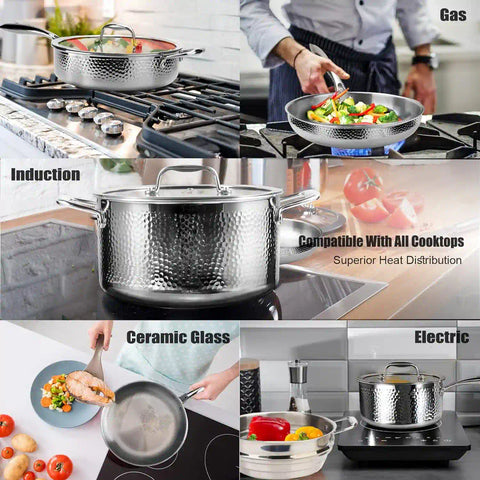TABLE OF CONTENTS
Are you looking for the best cooking pan for your kitchen? It can be quite confusing to choose between a cast iron pan and a stainless steel pan. Are you too confused and want to know which one will be the best in terms of cooking or cleaning?
There is no doubt both metals are quite popular when it comes to choosing the best cooking utensil or pan. So, to get a clearer view of which one to choose, you have to make sure that you have a complete overview of these two metals. Read on to know more.

Differences of Materials
Cast iron and stainless steel are both iron alloys, but they differ in carbon content. Cast iron contains 2% to 4% carbon, while stainless steel contains less than 2%.
Cast iron, a long-standing choice for cookware, is made by pouring molten cast iron (an iron alloy with 2% to 4% carbon) into a mold to cool and harden. The resulting product is then polished and seasoned or coated as needed.
Stainless steel, on the other hand, is an iron alloy with about 10.5% chromium and less than 2% carbon. Other elements are often added to create a material that resists rust and corrosion.
Despite its durability and non-reactive nature, stainless steel is a poor heat conductor, so it's often mixed with other materials when making cookware.
Understanding these differences can help you make informed decisions about your cooking and cleaning needs.

Differences When Cooking
Both the cooking pans made up of cast iron and stainless steel are great for cooking. But while the pans made up of cast iron are best for slow cooking or low cooking, the pans made up of stainless steel can be used for cooking everyday dishes.
Cooking With Cast Iron Pans
Cast iron pans, while reactive to acidic foods and heavy to handle, are favored for certain dishes due to their unique flavor-enhancing properties. Long cooking of acidic foods can degrade the pan's seasoning, but quick cooking is generally fine.
These pans require preheating before use to prevent food from sticking, and although they take time to heat up, they retain heat better than stainless steel once fully heated. Despite their weight and the time required to heat them, many prefer cast iron pans for the rich flavors they impart and the non-stick surface they can develop over time with proper seasoning.
Cooking With Stainless Steel Pans
Cooking with a stainless steel pan is a breeze. Thanks to its effective heat conduction, often enhanced by layers of aluminum or copper, it heats up quickly and evenly over medium heat. This ensures hassle-free cooking and a great culinary experience.
One of the key advantages of stainless steel over cast iron is its non-stick nature. This means your food won't stick to the pan, making it ideal for everything from a crispy stir-fry to a perfectly cooked dish with minimal oil. Even a cheese omelet is easy - just brush or coat the pan with some oil.
The versatility of stainless steel pans is another major plus. They're suitable for cooking a wide range of dishes, from omelets and sautéed vegetables to sauces and seared scallops. Whether you're preparing everyday meals or fancy dishes, stainless steel pans are a great choice.

Differences When Cleaning
When you are comparing the pans made up of cast iron vs. stainless steel, you have to compare their cleaning and maintenance process too. Of course, they are quite different from each other and so is their cleaning or maintenance process.
Technically, the pan made up of cast iron doesn’t need cleaning with soap and water. But it definitely needs more maintenance than that of the stainless steel pan.
Cleaning Of Cast Iron Pans
Upon unboxing, your bare cast iron cookware requires immediate seasoning. Initially, use warm water and soap to clean the cast iron cookware thoroughly.
This initial wash is crucial for eliminating any residues from the manufacturing process.Unlike other cookware, cast iron doesn't typically require hand washing.
After cleaning, it's essential to hand-dry the cast iron cookware immediately to prevent rusting. Following the drying process, the cookware should be seasoned with oil.
Maintaining your cast iron cookware involves cleaning and oiling after each use. Use a paper towel to remove excess oil and food particles, then rinse with hot water for a thorough clean
Cleaning Of Stainless Steel Pans
Maintaining stainless steel pans is straightforward. Unlike cast iron, these pans don't require complex care. Most manufacturers provide cleaning instructions, but typically, you can clean stainless steel pans using soap and water.
For stubborn grease or stains, warm water and soap combined with a soft sponge work effectively. Remember to dry your stainless steel pans thoroughly before storing them to ensure their longevity.

Why Stainless Steel Pan Beat Cast Iron?
While both cast iron and stainless steel pans have their advantages, stainless steel is often the preferred choice for many cooks. Stainless steel pans are durable, non-reactive, lightweight, and easy to clean and maintain. In contrast, cast iron pans are heavier, require more complex cleaning and maintenance, and take longer to heat up.
Despite their differences, both types of pans are versatile and can provide excellent cooking results. However, stainless steel's user-friendly nature makes it a more popular choice in modern kitchens.

Conclusion
Now that you know the differences between the cast iron and stainless steel, it is quite evident that you have figured out which is the perfect choice for you. In terms of stability, versatility and durability, both are great.
Hopefully, now it will be easier for you to pick the right metal when you are shopping for the best cookware for your kitchen.






















Leave a comment
All comments are moderated before being published.
This site is protected by hCaptcha and the hCaptcha Privacy Policy and Terms of Service apply.